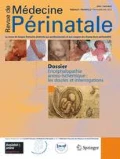Résumé
La hernie diaphragmatique n’est plus une urgence chirurgicale. Elle est une urgence de réanimation qui va permettre de mesurer l’importance de l’hypertension artérielle pulmonaire et de l’hypoplasie pulmonaire. Une fois que ces paramètres auront été évalués au mieux et (surtout) une fois que l’enfant aura été stabilisé, il pourra être opéré. Les voies d’abord et les techniques ont évolué au cours des dernières décennies, avec l’apport de la thoracoscopie et de la laparoscopie. La fermeture des larges défects passe par l’utilisation de prothèses ou d’un lambeau musculaire. Du fait d’un reflux gastro-œsophagien souvent associé, et dans les formes de hernie avec un large orifice, un geste antireflux peut être réalisé dans le même temps opératoire. La surveillance à long terme est justifiée par le risque de brides, de récidives et de croissance asymétrique de la cage thoracique pouvant conduire à la constitution de véritables scolioses.
Abstract
Congenital diaphragmatic hernia is no longer considered a surgical emergency. It is now current practice to delay the correction of the diaphragmatic defect until haemodynamic stabilization is obtained. Minimal invasive procedures, thoracoscopy and laparoscopy, are interesting new strategies. Patching is required to close large defects. Because of the high risk of gastroesophageal reflux, it may be advisable to perform an antireflux procedure at the same time. Long term follow-up is justified by the high incidence of complications and sequelae in more severely affected patients.
Références
Miguet D, Claris O, Lapapillonne A et al (1994) Preoperative stabilization using high-frequency oscillation ventilation in the management of congenital diaphragmatic hernia. Crit Care Med 22(Suppl. 9):S77–S82
Downard CD, Jaksic T, Garza JJ et al (2003) Analysis of an improved survival rate for congenital diaphragmatic hernia. J Ped Surg 38:729–732
Harting MT, Lally KP (2007) Surgical management of neonates with congenital diaphragmatic hernia. Sem Pediatr Surg 16:109–114
Moyer V, Moya F, Tibboel R et al (2002) Late versus early surgical correction for congenital diaphragmatic hernia in newborn infants. Cochrane Database Syst Rev 3:CD001695
Downard CD, Jaksic T, Garza JJ et al (2003) Analysis of an improved survival rate for congenital diaphragmatic hernia. J Ped Surg 38:729–732
Connors RH, Tracy T, Bailey PV et al (1990) Congenital diaphragmatic hernia repair on ECMO. J Pediatr Surg 25(10):1043–1046
Becmeur F, Reinberg O, Dimitru C et al (2007) Thoracoscopic repair of congenital diaphragmatic hernia in children. Semin Pediatr Surg 16(4):238–244
Szavay PO, Drew K, Fusch J (2005) Thoracoscopic repair of a right-sided congenital diaphragmatic hernia. Surg laparosc Endosc Percutan Tech 15(5):305–307
Moss RL, Chen CM, Harrison MR (2001) Prosthetic patch durability in congenital diaphragmatic hernia: a long-term follow-up study. J Pediatr Surg 36:152–154
Muratore CS, Kharasch V, Lund DP et al (2001) Pulmonary morbidity in 100 survivors of congenital diaphragmatic hernia monitored in a multi disciplinary clinic. J Pediatr Surg 30:133–140
Sydorak RM, Hoffman W, Lee H et al (2003) Reversed latissimus dorsi muscle flap for repair of of recurrent congenital diaphragmatic hernia. J Pediatr Surg 38:296–300
Stolar CJ, Levy JP, Dillon PW et al (1990) Anatomic and functionnal abnormals of the oesophagus in infants surviving congenital diaphragmatic hernia. Am J Surg 159:204–207
Kieffer J, Sapin E, Berg A et al (1995) Gastroesophageal reflux after repair of congenital diaphragmatic hernia. J Pediatr Surg 30(9):1330–1333
Fasching G, Huber H, Uray E et al (2000) Gastroesophageal reflux and diaphragmatic motility after repair of congenital diaphragmatic hernia. Eur J Pediatr Surg 10:360–364
Libretti L, Ciriaco P, Caretta A et al (2006) Endobronchial migration of prosthetic patch after congenital diaphragmatic hernia repair. J Pediatr Surg 41(1):e65–e67
Author information
Authors and Affiliations
Corresponding author
About this article
Cite this article
de Lagausie, P., Couchot, E., Benachi, A. et al. Prise en charge chirurgicale de la hernie diaphragmatique. Rev. med. perinat. 1, 37–41 (2009). https://doi.org/10.1007/s12611-009-0009-4
Published:
Issue Date:
DOI: https://doi.org/10.1007/s12611-009-0009-4

